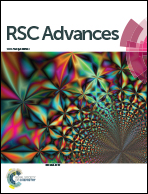Adsorption and reduction of hexavalent chromium on magnetic greigite (Fe3S4)-CTAB: leading role of Fe(ii) and S(−ii)†
Abstract
In this study, a facile one-step route was used to synthesize a novel magnetic mesoporous greigite (Fe3S4)-CTAB composite, which was utilized to remove hexavalent chromium (Cr(VI)). The optimized Fe3S4-CTAB0.75 composite with a CTAB dosage of 0.75 g possessed the maximum specific surface, showing the highest Cr(VI) adsorption capacity of 330.03 mg g−1. The mechanism analysis revealed that Fe(II) and S(−II) were critical for the reduction of Cr(VI). CTAB can promote the removal of Cr(VI) by Fe3S4-CTAB composites, possibly due to increased S(−II) concentration, better dispersion of nanoparticles, and greater zeta potential. Besides, there is mild effect of Fe0 on Cr(VI) removal, which is confirmed by the disappearance of the Fe0 peak from the XPS analysis. The pseudo-second-order kinetic model could explain the Cr(VI) removal processes well. The adsorption of Cr(VI) at different initial concentrations was more consistent with a Langmuir isotherm. The existence of H+ was beneficial for Cr(VI) removal by Fe3S4-CTAB0.75. Our work confirmed that the obtained Fe3S4-CTAB0.75 composites exhibit considerable potential for Cr(VI) removal from aqueous solution.



 Please wait while we load your content...
Please wait while we load your content...